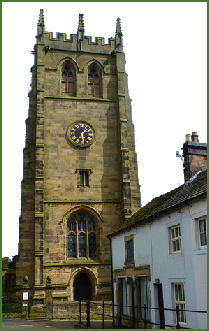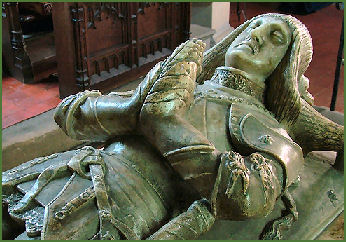Youlgreave
OS Grid ref:- SK209642
 The popular and picturesque village of Youlgreave (or Youlgrave) lies on the River Bradford, four kilometres to the south of Bakewell in the superb scenery of the White Peak.
The popular and picturesque village of Youlgreave (or Youlgrave) lies on the River Bradford, four kilometres to the south of Bakewell in the superb scenery of the White Peak.
An ancient village, Youlgreave is mentioned in the Domesday book where it is recorded as being owned by Henry de Ferrers. The name may derive from "yellow grove", the ore mined in the area is yellow. The village was once a centre of the lead-mining industry.
The Bull`s Head pub is a characterful old coaching Inn and dates to 1675, it boasts a superb carving over the courtyard entrance and retains many of its original features. The pub offers fine ales, freshly prepared food from local produce and bed and breakfast accommodation.
 Almost opposite the inn stands a squat circular structure known as the Fountain, which is actually a water reservoir holding 1500 gallons and was constructed in 1829 to provide water for the village. Opposite stands the youth hostel, which is housed in a Victorian building.
Almost opposite the inn stands a squat circular structure known as the Fountain, which is actually a water reservoir holding 1500 gallons and was constructed in 1829 to provide water for the village. Opposite stands the youth hostel, which is housed in a Victorian building.
Thimble Hall measuring 11ft 10in by 10ft 3in and standing but 12 feet high, holds a Guiness World Record's Certificate which proclaims it to be 'the world's smallest detached house'. It has 2 rooms measuring 8ft 1in by 7ft 1in which are connected by a ladder. The building dates from the eighteenth century, it was once home to a family of eight and has alternatively been used as a butchers, an antique shop and a cobbler's shop.
 The Old Hall (pictured right), a picturesque Grade II listed building, with stone gables and mullioned windows containing leaded lights, dates from 1650. Behind the hall lies the equally characterful Old Hall Farm which was built in a similar style in 1630.
The Old Hall (pictured right), a picturesque Grade II listed building, with stone gables and mullioned windows containing leaded lights, dates from 1650. Behind the hall lies the equally characterful Old Hall Farm which was built in a similar style in 1630.
The village church of All Saints (pictured left) is probably one of the most impressive churches in the Peak District, second only in size to Tideswell in the Peak District.
Records suggest the church to have had Saxon origins, the current structure was constructed in around 1130. It boasts a broad, perpendicular tower and Norman pillars. The Nave and North Aisle of the church are Norman and date from 1150-1170, but the arches above are early Gothic. The chancel and South Aisle were both added in the fourteenth century, while the tower is of fifteenth century construction.
 The unique circular font, which is adorned with animal motifs, dates back to around 1200, and originally came from Elton church. The painted glass window behind the altar was designed by Edward Burne-Jones and made in the William Morris workshops. The fifteenth century roof has bosses in the form of coats of arms and mythical creatures.
The unique circular font, which is adorned with animal motifs, dates back to around 1200, and originally came from Elton church. The painted glass window behind the altar was designed by Edward Burne-Jones and made in the William Morris workshops. The fifteenth century roof has bosses in the form of coats of arms and mythical creatures.
The chancel contains some fine medieval monuments, including the small alabaster effigy of Thomas Cockayne (pictured right), who was killed in a brawl in 1488, the effigy is dressed in armour and wears a collar of suns and roses, an emblem of the House of York.
In the north wall is the early fourteenth century effigy of a bearded knight holding his heart in his hands which is thought to represent Sir John Rossington. Also on the north wall opposite the entrance is a twelfth century cameo of what is thought to be a pilgrim, carrying a staff and bag. A superb alabaster reredos dating to 1492 commemorates Robert Gilbert, his wife Joan and their children. There is also a Jacobean monument of Roger Rowe dating from 1613 in the north aisle.
The village has a number of shops including a post office and gift shop and there are some spectacular walks in the area.
Nearby places of interest
Haddon Hall is an architectural gem. Dating back to the eleventh century, the hall has been described as "the most complete and most interesting house of [its] period", it is the finest example of a medieval manor house currently in existence in England.
Lathkill Dale, a Peak District beauty spot in the truest sense of the word, is one of Britain's finest limestone valleys, it is situated about 3 miles from Bakewell.
Arbor Low, sometimes referred to as ‘The Stonehenge of the North' is a prehistoric site of unique archaeological and cultural interest.
Monsal Head, a justly famous beauty spot, commands superb views down Monsal Dale and up the Wye Valley
Dovedale a dramatic limestone ravine, with its impressive rock outcrops and tranquil woodlands is arguably the prettiest and most famous of the dales in the Peak District National Park
